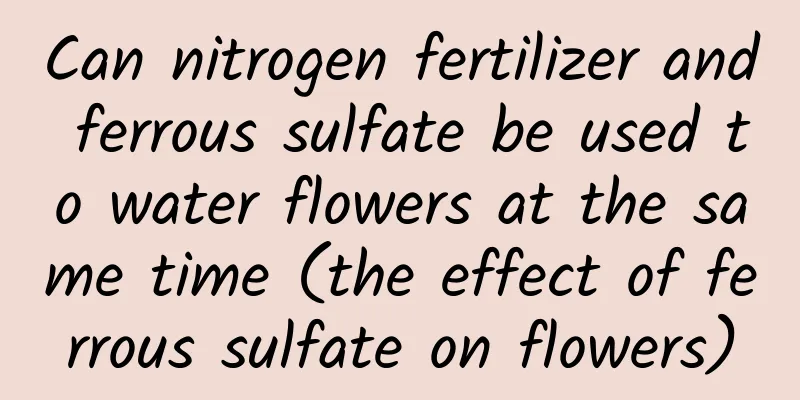When is the best time to plant tiger ginger?

|
Tiger ginger is not a plant of the ginger family, it is a plant of the Liliaceae family. Its scientific name is Polygonatum sibiricum, and tiger ginger is just a common name for it among the people. It has many nicknames, such as "immortal's surplus food" and "poverty relief". So when is the best time to plant tiger ginger? Let’s take a look below. 1. When is the best time to plant tiger ginger? Polygonatum sibiricum can be planted twice a year, in March-April in spring, or in September-October in autumn. However, it is still recommended that you plant it in spring. In spring, everything comes back to life, the plants have strong germination ability, the roots grow fast, and the temperature is also suitable. The growing period of Polygonatum is 2-3 years. If you plant Polygonatum in autumn, it will take more than one winter and the growth of Polygonatum will be affected in winter, so it is best to plant it in spring. 2. Conditions and methods for growing Polygonatum sibiricum 1. Planting conditions (1) Climate conditions: The suitable climate conditions for the growth of Polygonatum sibiricum are a warm and humid environment, with an average annual temperature between 11-19°C, an average temperature in January above 0°C, an average temperature in July below 20°C, and an annual rainfall of more than 1,000 mm. (2) Soil conditions: Polygonatum sibiricum grows best in loose, fertile, well-drained soil, preferably loam or sandy loam. The soil pH should be neutral or slightly acidic, and alkaline soil should be avoided. (3) Water source conditions: Polygonatum sibiricum needs sufficient water to grow, and should be planted in a place with convenient water sources to ensure normal growth and development of the plant. 2. Planting method (1) Seedling cultivation: Select healthy Polygonatum sibiricum seeds and use broadcasting or row sowing to cultivate seedlings. During the seedling raising period, the seedbed should be kept moist, weeds should be removed in time, and attention should be paid to the prevention and control of diseases and pests. (2) Transplanting: One year after seedling cultivation, transplant the Polygonatum cyrtonema seedlings into the field with a transplanting density of 20 cm × 30 cm. After transplanting, water the plants in time to ensure rooting and survival rate. (3) Fertilization: In the second year after transplanting, combine tillage and weeding with the application of appropriate amounts of organic fertilizer and compound fertilizer to promote the growth of Polygonatum sibiricum. (4) Pest and disease control: Common pests and diseases of Polygonatum include root rot, anthracnose, aphids, and moths. Comprehensive prevention and control measures should be taken, including strengthening field management, rational fertilization, regular spraying of fungicides , etc., to ensure the normal growth of Polygonatum sibiricum. (5) Harvesting and processing: Polygonatum sibiricum can be harvested 3-4 years after transplanting, usually in autumn. When harvesting, pay attention to protecting the root system, remove fibrous roots and mud and sand, wash and steam thoroughly, dry in the sun until half dry, then slice and dry. 3. Notes (1) Avoid using too much fertilizer and pesticide during the cultivation of Polygonatum sibiricum to avoid negative impacts on the soil and plants. (2) During the harvesting and processing process, the quality and appearance of Polygonatum sibiricum must be ensured to avoid damage and contamination. (3) For the control of diseases and insect pests, prevention should be the main approach, field management should be strengthened, and the disease resistance of plants should be improved. In short, the cultivation of Polygonatum sibiricum requires good climate, soil and water conditions, combined with scientific planting methods and precautions, to improve yield and quality. It is hoped that the majority of growers can take appropriate planting measures according to actual conditions and local conditions to achieve good economic benefits.
|
<<: How to care for irises and what are the propagation methods?
>>: Iris maintenance after flowering, why not bloom
Recommend
Flowering period of Murraya paniculata
Flowering time In fact, there are many names for ...
Fruit peel is better than flower fertilizer. Put a little bit of it on the leaves so they don't turn yellow and the flowers won't bend the branches.
Bananas are eaten all year round. If the peels we...
In the ugliest succulent contest, this is the ugliest one!
Ebisu Smile The first thing Huahua wanted to comp...
How to breed red powder taige
Propagation method of red powder pavilion: leaf c...
How to transplant mulberry trees
Preparation before transplanting mulberry trees D...
10 kinds of flowers that grow wildly and bloom all over the balcony in 3 months
Blue Snowflake Blue snow flower is one of Huahua’...
How long is the soybean growing period?
How long is the soybean growing period? The growi...
What to do if the leaves of Jiqiuli turn yellow
1. Natural shedding of metabolism The bottom leav...
The growing environment and local conditions of plums
Plum Growth Environment and Conditions Plums are ...
The efficacy of mosquito grass
1. Efficacy The mosquito grass with galls can be ...
How to pollinate cyclamen
How to pollinate cyclamen There are two ways to p...
Will Holly bear fruit in the second year? (Does Holly bear fruit in different years?)
Holly is a very popular potted plant during the C...
Ornamental pineapple not blooming? After learning this trick, your pots will be filled with flowers!
1. When does it usually bloom? If you want to mak...
Look at these 7 plants that absorb formaldehyde
Monstera Monstera is known to be the best in the ...
How to propagate and prune baby's breath
1. Cutting method 1. Cuttings: Cuttings of baby&#...









